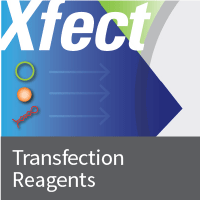Protein transfection reagents

The Xfect Protein Transfection Reagent uses a cell-penetrating peptide to bind and transport active proteins directly into a wide variety of mammalian cell types, including hard-to-transfect human suspension cell lines and mouse embryonic stem cells.
The Xfect Protein Transfection Reagent uses a cell-penetrating peptide to bind and transport active proteins directly into a wide variety of mammalian cell types, including hard-to-transfect human suspension cell lines and mouse embryonic stem cells.
What is the Xfect Protein Transfection Reagent and how does it work?
Xfect Protein Transfection Reagent is a modified peptide with cell-penetrating activity whose amino acid composition enables it to interact with a protein cargo and transport this protein across a cell membrane barrier. Just incubate your protein of interest with the Xfect reagent in the supplied buffer for 30 minutes and then apply the mixture to your cells. Two hours later you are ready to assay for protein activity.
Why transfect purified proteins directly?
Protein transfection is extremely rapid compared to traditional gene expression studies using transfected DNA (1–2 hours compared to 18–48 hours) because it bypasses cellular processes such as transcription and translation. It also facilitates studies involving transient effects of proteins, and avoids potentially harmful random DNA integration into the genome of the target cells. Xfect Protein Transfection Reagent makes it possible to deliver active proteins directly into cells for studies that involve transcriptional regulation, the cell cycle, apoptosis, oncogenesis, epigenetics, cell regeneration, and transdifferentiation.
What are the advantages of Xfect Transfection Reagent compared to other protein delivery technologies?
The two technologies most frequently used for protein delivery are based on lipids and cell-penetrating peptides. Lipid-based reagents tend to demonstrate high cytotoxicity, while peptide-based reagents transfect with low efficiency. Xfect Protein Transfection Reagent offers the best advantages of both, i.e., it retains low cytotoxicity and delivers more protein to a higher percentage of target cells (see Image Data tab in the product details section below). Moreover, Xfect Protein Transfection Reagent can transfect cells that are growing at a higher density than competing products, which is important since assays are often performed within a few hours post-transfection and the higher cell densities ensure sufficient material for downstream analysis.
Overview
- Transfect a large amount of active protein
- Virtually no cytotoxicity, unlike lipofection
- Very high efficiency, even in stem or hematopoietic cells
- Simple protocol—assay for your protein in just 2 hours
More Information
Applications
- Cell cycle studies
- Transcriptional regulation
- Protein localization
- Signaling pathway studies
- Apoptosis
- Oncogenesis
- Epigenetics
- Cell regeneration
- Transdifferentiation
Additional product information
Please see the product's Certificate of Analysis for information about storage conditions, product components, and technical specifications. Please see the Kit Components List to determine kit components. Certificates of Analysis and Kit Components Lists are located under the Documents tab.
Takara Bio USA, Inc.
United States/Canada: +1.800.662.2566 • Asia Pacific: +1.650.919.7300 • Europe: +33.(0)1.3904.6880 • Japan: +81.(0)77.565.6999
FOR RESEARCH USE ONLY. NOT FOR USE IN DIAGNOSTIC PROCEDURES. © 2025 Takara Bio Inc. All Rights Reserved. All trademarks are the property of Takara Bio Inc. or its affiliate(s) in the U.S. and/or other countries or their respective owners. Certain trademarks may not be registered in all jurisdictions. Additional product, intellectual property, and restricted use information is available at takarabio.com.



